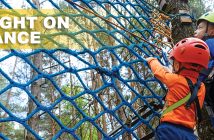ATTRACTIVE NUISANCE
The attractive nuisance doctrine is a legal rule that a landowner may be liable for hazardous objects or conditions on his land that injure children who are trespassing. The typical legal elements of an attractive nuisance lawsuit is that the landowner (think of the park) knew or should have known children were likely to trespass, there was a condition on the land that created an unreasonable risk of serious injury to such children, the children (due to their youth) did not understand the risk, the burden of eliminating the danger is slight compared to risk to the children, and the landowner did not exercise reasonable care to eliminate danger.
In most states, a landowner does not owe the same legal duties of care to trespassers as to people who are not trespassing. This makes sense, as a trespasser should not have the same rights as a paying guest who is where he or she is allowed. This is one of numerous reasons why signage to keep people from entering a particular area (whether posting closed signs, no trespassing signs, or employee only signs) is often a prudent risk management approach.
The attractive nuisance doctrine is an exception to this rule: It permits young children to recover under certain circumstances if they are injured while trespassing.
Attractive nuisances are hazardous objects or conditions that catch the eye of small children who are unaware of the dangers they present. Examples might include adventure parks and zip lines, closed merry-go-rounds, unattended power tools that are still plugged in, and unguarded crawl spaces.
To return to the previous example, if an adult dives into the shallow end of the pool while trespassing at night, he likely could not sue. However, if a young child was trespassing by the pool at night and decided to dive into the shallow end, the fact that the child was trespassing may not insulate the owner from liability under the attractive nuisance doctrine.
Courts disagree on whether a swimming pool can constitute an attractive nuisance. But fencing to keep children out of such locations usually protects a park from liability.
LIABILITY RELEASES
Most states, but certainly not all states, enforce releases signed by guests agreeing not to sue prior to them engaging in an activity. For adventure parks, releases can be a critical risk management tool. However, fewer states enforce releases when the injured person is a child as opposed to an adult. While some states, such as California and Colorado, enforce releases signed by parents on behalf of their children, many states do not. So, there may be greater liability exposure in many locations for lawsuits involving children due to the lack of enforceability of releases.
That said, indemnity clauses and choice of jurisdiction clauses may still be applicable with children and provide some protection. You should consult with your attorney in developing releases regarding children, so that the park has maximum protection under your state’s law.
STATUTE OF LIMITATIONS
A statute of limitations acts to bar stale claims—it prevents people from bringing lawsuits after a certain number of years after the date of the accident. These statutes of limitations vary, depending upon the state, between (usually) two and six years.
An accident involving a child, however, often has the practical effect of greatly extending the statute of limitations. While the statute of limitations continues to run for children in some states, in many states the statute of limitations does not begin to run until after the child becomes an adult.
For example, in Colorado, the statute of limitations is generally two years from the date of the accident. In the case of children, however, the statute of limitations does not begin to run until the child turns 18.






